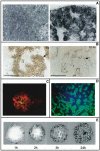Antibody tumor penetration: transport opposed by systemic and antigen-mediated clearance
- PMID: 18541331
- PMCID: PMC2820307
- DOI: 10.1016/j.addr.2008.04.012
Antibody tumor penetration: transport opposed by systemic and antigen-mediated clearance
Abstract
Antibodies have proven to be effective agents in cancer imaging and therapy. One of the major challenges still facing the field is the heterogeneous distribution of these agents in tumors when administered systemically. Large regions of untargeted cells can therefore escape therapy and potentially select for more resistant cells. We present here a summary of theoretical and experimental approaches to analyze and improve antibody penetration in tumor tissue.
Figures



Similar articles
-
Theoretic criteria for antibody penetration into solid tumors and micrometastases.J Nucl Med. 2007 Jun;48(6):995-9. doi: 10.2967/jnumed.106.037069. Epub 2007 May 15. J Nucl Med. 2007. PMID: 17504872
-
Transport of fluid and macromolecules in tumors. III. Role of binding and metabolism.Microvasc Res. 1991 Jan;41(1):5-23. doi: 10.1016/0026-2862(91)90003-t. Microvasc Res. 1991. PMID: 2051954
-
Theoretical analysis of antibody targeting of tumor spheroids: importance of dosage for penetration, and affinity for retention.Cancer Res. 2003 Mar 15;63(6):1288-96. Cancer Res. 2003. PMID: 12649189
-
The macroscopic and microscopic pharmacology of monoclonal antibodies.Int J Immunopharmacol. 1992 Apr;14(3):457-63. doi: 10.1016/0192-0561(92)90176-l. Int J Immunopharmacol. 1992. PMID: 1618598 Review.
-
Brain Disposition of Antibody-Based Therapeutics: Dogma, Approaches and Perspectives.Int J Mol Sci. 2021 Jun 16;22(12):6442. doi: 10.3390/ijms22126442. Int J Mol Sci. 2021. PMID: 34208575 Free PMC article. Review.
Cited by
-
EpCAM-Binding DARPins for Targeted Photodynamic Therapy of Ovarian Cancer.Cancers (Basel). 2020 Jul 2;12(7):1762. doi: 10.3390/cancers12071762. Cancers (Basel). 2020. PMID: 32630661 Free PMC article.
-
COBRA™: a highly potent conditionally active T cell engager engineered for the treatment of solid tumors.MAbs. 2020 Jan-Dec;12(1):1792130. doi: 10.1080/19420862.2020.1792130. MAbs. 2020. PMID: 32684124 Free PMC article.
-
Understanding Inter-Individual Variability in Monoclonal Antibody Disposition.Antibodies (Basel). 2019 Dec 4;8(4):56. doi: 10.3390/antib8040056. Antibodies (Basel). 2019. PMID: 31817205 Free PMC article. Review.
-
Predictive Simulations in Preclinical Oncology to Guide the Translation of Biologics.Front Pharmacol. 2022 Mar 3;13:836925. doi: 10.3389/fphar.2022.836925. eCollection 2022. Front Pharmacol. 2022. PMID: 35308243 Free PMC article.
-
Shelf-Life Extension of Fc-Fused Single Chain Fragment Variable Antibodies by Lyophilization.Front Cell Infect Microbiol. 2021 Nov 15;11:717689. doi: 10.3389/fcimb.2021.717689. eCollection 2021. Front Cell Infect Microbiol. 2021. PMID: 34869052 Free PMC article.
References
-
- Weinstein J, Eger R, Covell D, Black C, Mulshine J, Carrasquillo J, Larson S, Keenan A. The pharmacology of monoclonal antibodies. Ann. N.Y. Acad. Sci. 1987;507:199–210. - PubMed
-
- Minchinton AI, Tannock IF. Drug penetration in solid tumours. Nat. Rev., Cancer. 2006;6(8):583–592. - PubMed
-
- Baxter LT, Jain RK. Transport of fluid and macromolecules in tumors. I. Role of interstitial pressure and convection. Microvasc. Res. 1989;37(1):77–104. - PubMed
-
- Baxter LT, Jain RK. Transport of fluid and macromolecules in tumors. III. Role of binding and metabolism. Microvasc. Res. 1991;41(1):5–23. - PubMed
-
- Fujimori K, Covell D, Fletcher J, Weinstein J. A modeling analysis of monoclonal antibody percolation through tumors: a binding-site barrier. J. Nucl. Med. 1990;31:1191–1198. - PubMed
Publication types
MeSH terms
Substances
Grants and funding
LinkOut - more resources
Full Text Sources
Other Literature Sources

